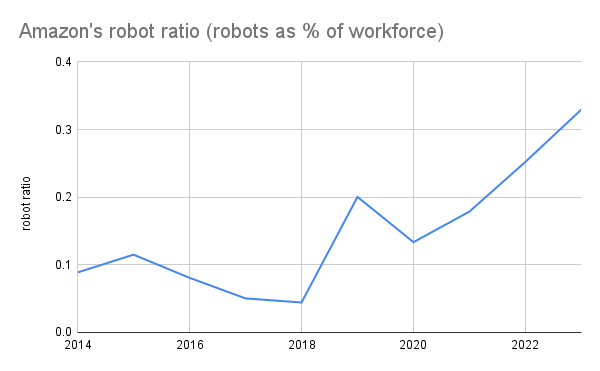Robot ratio: A key stat for identifying great businesses
The question is when, not if, a tech company will have more robots than humans in its workforce.
I’ll make the case that Amazon is likely to be the world’s first company with more robots than humans.
Amazon has called itself the world’s largest manufacturer and operator of industrial robotics. These robots make its fulfillment centers more efficient. Amazon is also working on drone delivery (Amazon Prime Air) and its owns Zoox, which is building robotaxis.
Amazon is unique in that it occasionally says how many robots it has.
There’s been a sharp uptick in robots in recent years. Its human workforce has plateaued since the pandemic. I’ll go out on a limb and predict than Amazon will have more robot than human workers in 2029. (Place your own bet in the comments.)
I expect smart analysts to begin tracking what I call “robot ratio,” the percentage of a company’s workforce that is robots. You can see Amazon’s ratio has steadily grown the last 10 years.
This tells me that Amazon is serious about leveraging tech to amplify the potential of its human workers, delight customers and grow its business.
I expect we’ll eventually get to a point where the SEC requires companies to reveal how many robots they have. The SEC didn’t always require companies to reveal how many human employees they had. (That appears to have changed in 1973.)
I haven’t found another major company that reveals robot numbers like Amazon. But Amazon does have competition. Google — thanks to Waymo and Wing — is an obvious competitor to be the first company with more robots than humans. The same goes for Tesla with its Cybercab and Optimus robot.
I think robot ratio is a valuable metric, but also a crude one. It may not account for the complexity, size or scale of a robot that a company is using. All humans are created equal, but not all robots.
What businesses do you think are using robots best? And who could rival Amazon?




